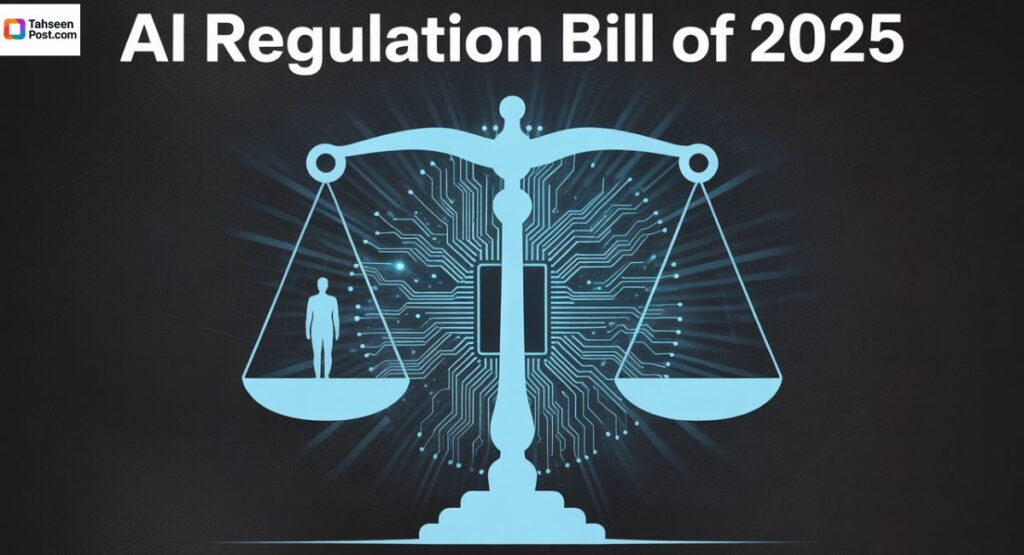The U.S. introduces a sweeping AI regulation bill in 2025, centralizing control at the federal level and reshaping compliance rules. Discover the key provisions, their impact on businesses, and what it means for innovation and consumer protection.
AI Regulation Bill in the U.S: What the New Bill Means for Businesses and Consumers
Introduction
The United States has entered a decisive phase in regulating artificial intelligence. In 2025, Congress is pushing forward a comprehensive AI regulation bill, signaling a shift toward centralized federal oversight and away from fragmented state-level rules.
This legislative package—often referred to as the Big Beautiful Bill—aims to unify AI governance, simplify compliance for companies, and maintain America’s global leadership in technology. But it has also ignited intense debate about consumer protection, state autonomy, and the ethical deployment of AI.
This article AI Regulation Bill breaks down the key components of the new AI bill, its business implications, and what organizations need to do to stay compliant.
1. Federal Preemption: The Core of the AI Regulation Bill
At the heart of the legislation is a federal preemption clause that would invalidate state-level AI regulations for up to a decade. This means that pioneering laws like California’s SB 1047 or New York’s RAISE Act could be suspended.
Why This Matters
- Business Simplification: A single federal framework prevents a patchwork of state laws that complicate compliance.
- Consumer Risk: Critics argue this move eliminates critical local protections against AI bias, deepfakes, and surveillance abuses.
Duration of Preemption:
Originally set at 10 years, the moratorium may be reduced to five years for states participating in federal broadband programs, according to recent Senate negotiations.
2. The Executive Order and AI Action Plan
Alongside legislative efforts, the White House issued Executive Order 14179, which reshaped AI priorities:
- Rollback of Biden-era directives
- Acceleration of innovation to counter China
- Prohibition of “woke AI” in federal use
- Promotion of domestic AI infrastructure and defense integration
The AI Regulation Bill emphasizes open-source adoption, streamlined approvals, and incentives for U.S.-based AI development.
3. Supporting AI Legislation
Several additional bills complement the main regulation:
- TAKE IT DOWN Act—Requires platforms to remove non-consensual AI-generated deepfake content within 48 hours.
- CREATE AI Act—Establishes the National AI Research Resource to provide affordable compute and data access for innovators.
- No Adversarial AI Act—Bans the use of AI tools developed in adversarial nations such as China or Russia in federal agencies.
- Stop AI Price Gouging Act—targets algorithmic pricing practices that exploit consumer data for unfair price setting.
4. Industry and Consumer Impact
Ai and Silicon Valley replacing the government bill? 🤔🤔🤔
— Matt From Cultivate Elevate (@CultivateElevat) May 26, 2025
SEC. 43201. ➡️https://t.co/yWpRLRP57b
Source: https://t.co/nRXQcsatuq pic.twitter.com/TdKGgB9UuC
Business Benefits
- Unified Compliance: Companies operating across multiple states gain predictability.
- Accelerated Innovation: Reduced regulatory barriers mean faster deployment of new AI applications.
Consumer Concerns
- Data Privacy Risks: Preemption limits states’ ability to enforce transparency requirements.
- Accountability Gaps: Without local enforcement, recourse for algorithmic harm may weaken.
Global Competitiveness
The law aims to ensure U.S. dominance in AI amid fierce competition with China. Export restrictions on AI chips and foreign sourcing limits reinforce this strategy.
5. How Businesses Should Prepare
- Update Compliance Programs: Align with the NIST AI Risk Management Framework and federal reporting requirements.
- Strengthen AI Governance: Implement bias detection, human-in-the-loop review, and audit trails for high-risk systems.
- Engage in Policy Dialogue: Stay informed and participate in industry associations to shape future guidance.
FAQs
Q1: What is the main goal of the AI regulation bill?
A1: To centralize AI oversight under federal law, simplify compliance, and accelerate innovation while maintaining national security.
Q2: Does this mean states cannot regulate AI at all?
A2: Yes, during the moratorium period (5–10 years), states will be preempted from enacting or enforcing AI-specific laws.
Q3: How does this affect startups and small businesses?
A3: The bill may lower compliance burdens but also limits state-level consumer trust frameworks that smaller firms often rely on.
Q4: What about AI bias and deepfakes?
A4: The federal government plans to handle these issues through separate laws like the TAKE IT DOWN Act and future FTC enforcement guidelines.
Q5: Will this impact U.S.-China tech rivalry?
A5: Yes. The law is designed to boost domestic AI capacity and restrict the influence of adversarial nations on critical U.S. systems.
Conclusion
The AI Regulation Bill of 2025 marks a turning point in America’s approach to artificial intelligence governance. While businesses may welcome a simplified compliance landscape, critics argue that preempting state laws risks weakening consumer protections.
The next few months will be crucial as Congress finalizes the bill and industry stakeholders adapt to a new era of federalized AI governance. For businesses, early compliance preparation is not just advisable—it’s essential.

